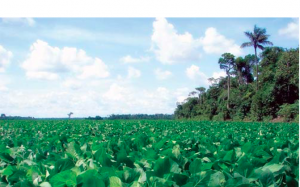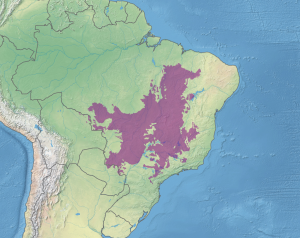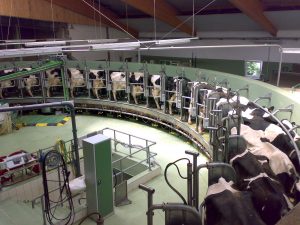Got Milk?
Andrew Murray
In 1993, the California Milk Processing Board commenced an aggressive advertising campaign coining the phrase, “got milk?” For many millennials and Gen Z-ers, this brings back images of elementary school cafeterias with advertisements hung up referencing their infamous campaign slogan. As Americans, we have become dependent on dairy. Every day Americans consume dairy at almost every meal: milk with cereal when you hop out of bed, or the slice of Velveeta cheese on your hamburger, to the whipped cream you put on your ice cream sundae. While an illustration of a dairy cow on the side of a milk carton may exude images of innocence and Midwest tradition, the true environmental cost of dairy milk is staggering. A number of concerns have been raised with modern-day dairy milk practices, ranging from animal welfare to water use to deforestation. As more scientists have investigated the environmental effects of commercial dairy production, their findings are jarring and reflect the damaging environmental consequences of dairy milk production.
In 2020, milk sales in the United States amounted to 46.22 billion pounds of milk sold. Across the pond in the United Kingdom, milk accounted for 16.4% of total agricultural output for the 2020 year. While 65% of the human population suffers from a reduced ability to digest dairy, American and European obsession with this delicate cream reign supreme. While the meat industry has come under increased scrutiny for its livestock practices, dairy products have avoided the hot seat. Most people would characterize dairy milk production as rather simple; cows only need food, water, and space to graze. While the inputs of production: food, water, and land, seem feasible and rudimentary, they are increasingly coming at a massive environmental cost. This love for dairy products only seems to be growing, and many don’t understand the true environmental costs of the industry.
Food
Like any other living, breathing, animal, cows need food. A milk-producing dairy cow will eat around 1.5-2% of its body weight every day. For those not as familiar with dairy farming, that equates to around 16-20 pounds of hay (MFA, 2020). Hay, which was the main diet for cattle before 1950, takes up a lot of space and does not offer a lot of protein. At the conclusion of World War Two, the United States experienced a period of great prosperity with rising standards of living seen across the country. This led people to better their diet, creating an increased demand for cow-based products. Soon, farmers began turning to soybeans for their cattle feed. Soybean meal is very high in protein and offers farmers the ability to quickly ripen their cattle. According to the health blog “All Plants”,“75% of the world’s soy is used for animal feed” 75% of the world’s soy is used for animal feed (2019). Soybeans have become the dominant contemporary animal feed, and with the help of government subsidies, the price for the crop has remained low. However, this dependence on soybeans has created a ripple of environmental consequences.
Today, there are three countries that dominate soybean production: The United States, Brazil, and Argentina. The United States produces 35% of global soybean production but does so in a responsible way, only farming on arable farmland and utilizing a rotating crop system. The environmental concerns primarily arise when looking at Brazil’s soybean production. Brazil’s two largest contributors to greenhouse emissions are cattle ranching (71%) and deforestation tied to soy farming (29%). In recent years, many news outlets have reported on deforestation practices in Brazil, particularly focusing on the Amazon rain forest.

As Brazil inched into the 1990s, a series of deregulations occurred as the Brazilian economy shifted away from previous import substitution industrialization and began integrating into international markets known as globalism. Agriculture was a massive export for Brazil, and still is today, and soon vast amounts of land were opened up for sale for cheap. This land was primarily located in the Amazon rainforest. After the massive deregulation push, multinational corporations began buying thousands of hectares of land in Brazil rain forests and converting them into tillable fields for soybeans.
In Brazil, researchers have found a direct relationship between soy production in connection to dairy and beef prices. This relationship means a slight increase in consumer needs for cow products results in increased deforestation. Between 2005-2007, when beef and dairy prices declined, deforestation in Brazil decreased. However, when prices rose in 2008 so did deforestation (Zycherman, 2016). The Cerrando Basin, where most deforestation occurs in Brazil, contains 5% of the world’s animal species.

Deforestation affects the biodiversity of the area, risking the water security of the plants and animals residing in the Basin. Additionally, most of Brazil’s soybeans are exported to European nations. This incurs additional environmental costs as shipping is responsible for 3% of global Co2 emission equating to one billion tons of Co2 annually. While many consumers picture the image of dairy cows eating hay and living on happy farms, the reality reflects the taxing effects of producing soy feed.
Water
Over the last 10 years, as droughts and wildfires have ravaged parts of the world, clean drinking water has become an increasingly valuable commodity. There is a heightened social awareness to limit water use, but not when it comes to dairy production. A milking dairy cow requires 30-50 gallons of water a day. In comparison, the average human drinks around eight cups of water a day equating to half a gallon. An estimated 70% of our global freshwater supply is used for agriculture (MSU Agriculture, 2020). While modern American farming has worked to optimize water use, their Brazilian counterparts cannot say the same. Most Brazilian farmers have a lack of information or no concern about water-use efficiency (Neumann, 2020). Brazil enjoys the luxury of having 13% of the world’s freshwater as well as relaxed regulations which do not limit water use. Experts have criticized Brazil’s farming practices and have warned that excess water use could have detrimental environmental effects including the reduction of river flow, the salinization of irrigated areas, and the destruction of wild habitats.

Dairy farmers use water for their cattle but also in the dairy production process. While dairy cows require gallons of water for daily consumption, dairy producers need water in almost every process of production from the preparation room, to the milking room back to the trough. Little research has gone into this area of dairy production. Unknown to many consumers, cows require cleaning before milking. A dirty cow could tamper with the quality of milk and therefore farmers use unspecified amounts of water for not only their cows to drink but to bathe them as well. While there is little research into how many gallons of water is used to bathe cows, there is information about the milk room. The milk room requires water for the sanitation of equipment. Some studies from Europe estimate that cleaning water use was 0.2-0.4 L of water per kg of milk. In comparison, studies from Brazil estimate that around 1.3 L of cleaning water is required per kg of milk (Kraatz, 2016). That means a little more than an 8-ounce water bottle is required for every kg of milk produced in Brazil. While dairy farming requires large amounts of water, so does the food they feed their cattle with.
As mentioned earlier, the primary feed of cattle is soy meal. According to MSF Agriculture, soybeans are one of the most water-intensive crops. Soybeans require approximately 18-25 inches of water from the plant to harvest (2020). In India, where lax environmental regulations run free, it takes approximately 900 liters of water to produce one kilo of soybeans. As rising populations lead to the increased need for animal food, soybeans are the cornerstone of this growth fueling the livestock and dairy industry. From 2002-2008, Brazil increased its soybean production by 30%. As of today, 33% of agricultural land is being used to grow soybeans (Garrido, 2020). Brazil, similarly to India, has few environmental regulations or incentives to push farmers towards limiting their water use. Additionally, their farming technology has lagged behind the United States and other Western countries. As water is becoming a more coveted resource, consumers of dairy milk must be aware of the environmental costs the globe incurs every time a gallon of milk is purchased.
Land
Space on our Earth is finite, and currently, 26% of the world’s ice-free land is being used for cattle grazing, and 33% of cropland is being used for cattle food production. Approximately 270 million cows are used for current dairy production needs (WWF, 2020).

As discussed in the case of Brazil, the need for grazing fields has contributed to deforestation just as soy production has. The deforestation initiatives have dire environmental consequences and risk water security, biodiversity, and increase Co2 emissions. Domestically, The United States has its own problems when looking at land use dedicated to dairy farming.
Within the United States, a number of concerns have been raised about the environmental consequences of large amounts of land being used for raising cows. Dairy cows produce massive amounts of waste, and when not managed properly can emit massive amounts of methane. On many commercial dairy farms, there have been reports of irresponsible waste management. This waste is often concentrated on land primarily used for cow grazing. In some instances, cow waste has sept into surface water reservoirs like ponds and streams. When this happens, it is incredibly harmful to the water supply and expensive to clean up. If cow waste is not properly managed, the environmental consequences can be steep, damaging not only the land on which dairy farming is taking place but also the land surrounding the farm (University of Minnesota, 2020). While it is clear that dairy farming has incredible environmental consequences, alternatives to dairy are in the market and becoming more popular as people move away from dairy.
Alternatives
In the last 30 years, dairy alternatives have become much more mainstream. While this partly stems from more dairy alternatives, it also manifests from the United States’ increase in veganism and environmental consciousness. Between 2004 to 2019, one survey finds, veganism in the United States increased by 300% (Sentiment Media, 2021). Today, if anyone walks into the dairy section of a major grocery retailer, they find conventional dairy milk but also soy, almond, oat, and lactaid free milk alternatives. When asked what the best plant-based alternative to dairy milk is, Indiana University Professor of Anthropology, Andrea S. Wiley, who researches domestic dairy milk consumption, responded, “Soy milk is the only plant-based milk which replicates the nutritional value of dairy milk, anything else is white water.” Soy milk, made from ground soybean, has faced scrutiny for contributing to deforestation in the Amazon. The other alternatives, almond and oat milk, have a rather small environmental impact. Oat milk requires little water and oats can be grown in cooler arid climates. Similarly, almond milk has traditionally been a water-intensive nut but advances in technology have been able to cut down water use by 20%. These three kinds of milk have become increasingly popular as the market for alternatives for dairy milk grows.
While alternatives continue to pop up, Professor Wiley explained, “there is still a cultural edifice which props up dairy milk.”“there is still a cultural edifice which props up dairy milk”Western society has become enjoined with this tasty cream, and marketing campaigns have pushed the illusion humans need milk in everyday life. American nutritional calcium requirements are the highest of any developed country, yet as Professor Wiley explained, “dairy is not necessary for the human diet and that message is often lost with parents who think their children need milk.” Children are the main drivers of dairy milk consumption and outdrink their adult counterparts. However, milk sales have been annually decreasing from their World War Two high, and Professor Wiley’s outlook on the industry is grim, saying, “there are many other milk options and consumers are becoming more aware of the environmental effects surrounding milk production.” As American and European cultures become more environmentally vigilant, the dairy industry will face numerous challenges to reduce its environmental impact. Additionally, with the increased popularity of plant-based diets, combined with decreased birth rates, the need for conventional milk will only decrease. Dairy milk has represented a cornerstone of Western diets, but its high environmental inputs raise the question of its value. While American’s still love dairy products, the desire for milk is waning.
REFERENCES
Greenhouse gas, water, and land footprint per unit of production of the California dairy industry over 50 years. Journal of Dairy Science . (2020, February 6). Retrieved December 7, 2021, from https://www.journalofdairyscience.org/article/S0022-0302(20)30074-6/fulltext.
Is soy bad for the environment? allplants. (n.d.). Retrieved December 7, 2021, from https://allplants.com/blog/lifestyle/the-truth-about-soy-and-the-environment.
Murray, Andrew. Wiley, Andrea S. (2021, December 8th). [In-Person Interview with Professor Andrea S. Wiley].
Neumann, N. F., Neumann, L. A., Belli Filho, P., & Tavares, J. M. R. (2020, March 1). Efficiency of water use in a dairy industry: A case study from Campo Largo, Brazil. Water Supply. Retrieved December 7, 2021, from https://iwaponline.com/ws/article/20/2/45 9/71097/Efficiency-of-water-use-in-a-dairy-industry-a-case.
U.S. National Library of Medicine. (2020, August 18). Lactose Intolerance: Medlineplus Genetics. MedlinePlus. Retrieved December 7, 2021, from https://medlineplus.gov /genetics/condition/lactoseintolerance/#:~:text=Approximately%2065%20percent%20of%20the,people%20affected%20in%20these%20communities.
Which crops consume the most water? MSFAgriculture. (2020, January 27). Retrieved December 7, 2021, from https://msfagriculture.com/2020/01/18/which-crops-consume-the-most-water/.
Zycherman, A. (2016). Cultures of Soy and Cattle in the Context of Reduced Deforestation and Agricultural Intensification in the Brazilian Amazon. Environment and Society, 7, 71–88. https://www.jstor.org/stable/26204972
